
Nothing compares to the simple pleasure of a bike ride. J.F.Kennedy
Search this website
To Iguazu Falls
Asunción, San Lorenzo, Caacupe, Eusebio Ayala, San José, Coronel Oviedo, Caaguazú, Juan E.O'Leary, Ciudad del Este, Foz do Iguacú (Brazil), Puerto Iguazú (Argentina)
Getting Ready for the Journey
My old Asus laptop, which had served well on my five earlier trips, gave up the ghost. It was most likely due to the screen connection which turned on only after about ten attempts to adjust the display tilt. I purchased a similar one — an Asus Transformer Book running Windows 8.1. However, this turned out to be a problem. Everything worked as it should until the very moment when I tested the converter between USB and IrDA. The transfer of data from the Polar cyclocomputer requires an infrared transfer. This worked well on Windows 7, but not on Windows 8. I bought an additional two converters, luckily they only cost about CZK 100 ($5) but with no luck. In the end, I purchased an expensive converter directly from Polar which came with a Windows 8 driver. This one, however, only worked for about 12 seconds and then would disconnect itself. Not even checking the energy-saving modes for changing the settings helped. Luckily I found a solution – I would first download the list of records from the cyclocomputer and then, after one download, I would download individual entries for each of these records. It seemed as if these 12 seconds for downloading data from each record would be sufficient. A consequence of this was that what previously took me about 30 seconds, would from then on take about 10 minutes. Progress can never be prevented.
Another interesting experience was with Garmin. I wanted to purchase the maps for Oregon 550T navigation. I had used the City Navigator in North America and was very pleased with it, especially when searching routes through big cities. So I wanted to get the same maps for South America. The map was in stock, as stated on their website, so I placed the order at the beginning of August. By the end of August, I received a phone call informing me that they were still not in stock and that they could instead provide me with Open Source maps, which were free of charge (from a project other than Garmin). They would only charge CZK 200 ($10) for each country downloaded for me. I refused, as I could download and install these myself. I made one more attempt and tried purchasing a downloadable map directly from Garmin's own website. With no luck. I could not understand how it was possible that, in the digital age when everything could be purchased online with immediate effect (e.g. when purchasing goods from Amazon), Garmin would make online purchases impossible. And they are not selling any cheap stuff. City Navigator usually costs about $100.
I dusted off my Spanish with my favorite textbook: "Simplified Spanish". I reviewed about 500 basic words and 100 phrases. I would learn the rest according to requirements during the trip.
Asuncion
After 17 hours on the plane (flight from Amsterdam to Buenos Aires itself takes 13.5 hours), I landed in Asuncion. From the aircraft window, I could see my two boxes being unloaded. This pleased me. The airlines had improved remarkably, as the last time my luggage had been lost was in 2007 on my flight to Alaska. This never again happened after that time. I assembled the bicycle in front of the Airport, accompanied by many curious people, so I got to practice my Spanish conversation a little. One man even filmed an interview with me, promising he would send it to the TV. My Spanish was really rusty. I was curious to see if he would keep his promise to send me the edited film by e-mail (he did not).
Two hours later, I was ready. The bicycle was assembled with all the panniers on it. I returned to the Airport terminal, only to be immediately kicked out again by the police, as entering with a bicycle was not permitted. I parked outside and went in again to withdraw some cash. At the first cash machine, I was eagerly observed by about ten people, so I went to another one which was not so exposed. From there, I was chased away by heavily armed security guards who had come to replenish the cash. Right next to the ATM was a Global Exchange desk where it was possible to withdraw money by credit card. The transaction worked only at the 3rd attempt and I suddenly had a million in my pockets (the exchange rate was CZK 5 to 1000 Gurani, so CZK 5000 ($250) quickly resulted in a million).
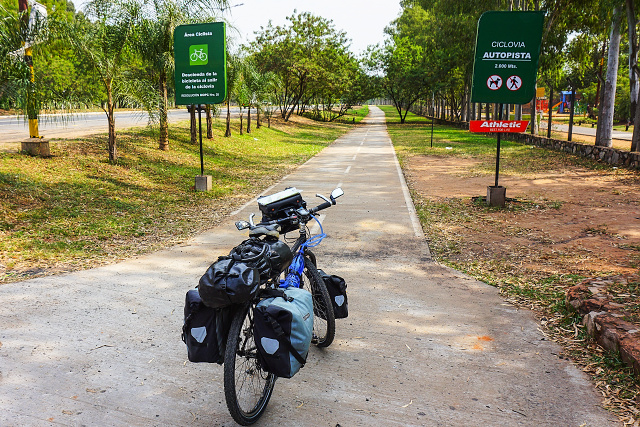
Asuncion: Start of 2-km cycle path near the Airport
The trip to Asuncion center was annoying – heat, damaged verges, heavy traffic. The only exception was the cycle path around a park close to the Airport which, however, was only 2 km long. I found accommodation in the Nomada Hostel, thanks to the GPS navigation. All quite pleasant, about CZK 400 ($20) for a single en suite room. The garden there had a small swimming pool and breakfast was included. I immediately tasted the local Paraguayan beer, which was surprisingly called – Pilsen. A one-liter bottle for about CZK 65 ($3.25). The beer would not disappoint Plzeò, it was drinkable.
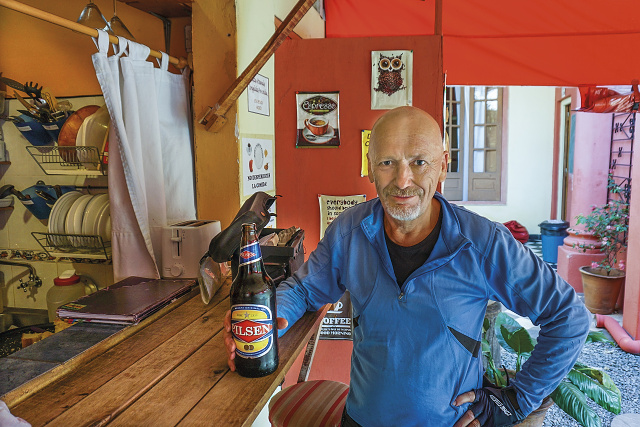
Asuncion: In the hostel, enjoying Paraguayan beer with a typical Latin-American name: Pilsen
Shocks
I checked my e-mail and then my credit card account, from which I had withdrawn cash at the Airport. I was shocked, the withdrawal was shown twice. I took a screenshot of the statement in jpg format, took my laptop, paper receipt for the withdrawal and headed for the bus stop to take a bus to the Airport. Suddenly I heard a loud bang. A motorcyclist had landed in the road on the opposite corner, having collided with a car. He lay there without moving, not even crying in pain. As if he was dead. Other people reached the same conclusion, ignored him and only moved the crashed motorbike off the road to free the traffic flow. I did not see what happened next, as my bus had just arrived. I then discussed the monetary issue at the Airport and they promised to check with the bank. In the case of two withdrawals, they would make sure that the money was returned to me. Exhausted by the flight, 6-hour time difference and the events of the past hours, I hit the sack and slept for 11 hours.
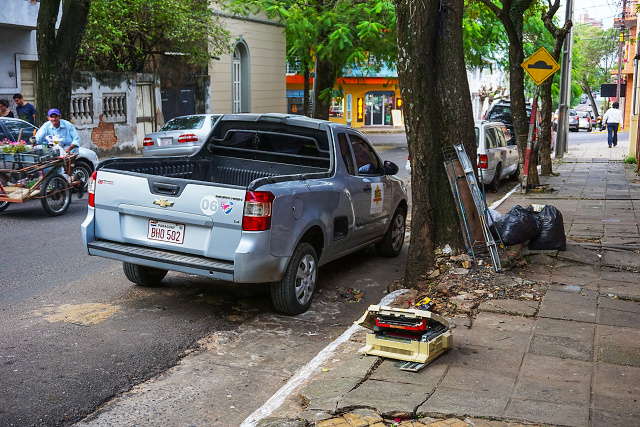
Asuncion: This is what pavements in the city center look like
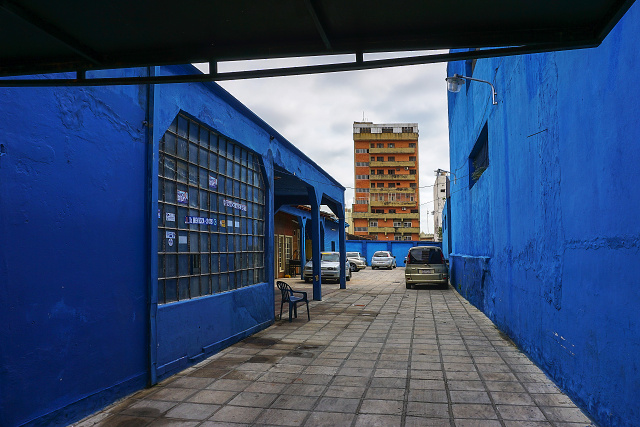
Asuncion: Courtyard in the center
The following day, I received an e-mail from Global Exchange, stating that everything was in order and that they had only received one payment. If I did not agree, I could go the Bankcard bank in Asuncion. I headed there immediately in the morning, their office was located in Avenida Brasilia. I found Brasil Street on the map, as it was close to the hostel, so I walked there. Already when walking along that street, I knew that no bank was located there. I finally figured that Brasil Street was not Avenida Brasilia. Using my Spanish, I asked a passer-by which way to go. He understood and gave me directions which then clarified that it was about 3 to 4 km away.
The bank was huge, modern and imposing, so I was on my best behavior. I addressed the lady at the reception with Buenos dias Senora, instead of my usual Hola guapa! (hello, beautiful!), and asked for an English-speaking employee. I then discussed the issue with him and he showed me on his monitor the transactions made on my card. Global Exchange had charged me twice. However, one day later, after I had lodged the complaint with them, one of the transactions was cancelled. I just could not tell if it was their "way of business" or a random mistake. Some days later, when the transactions cleared, everything should be resolved.
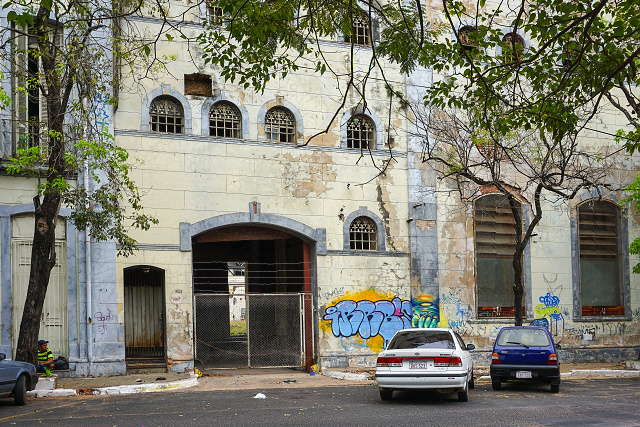
Asuncion: Some older buildings could be nice
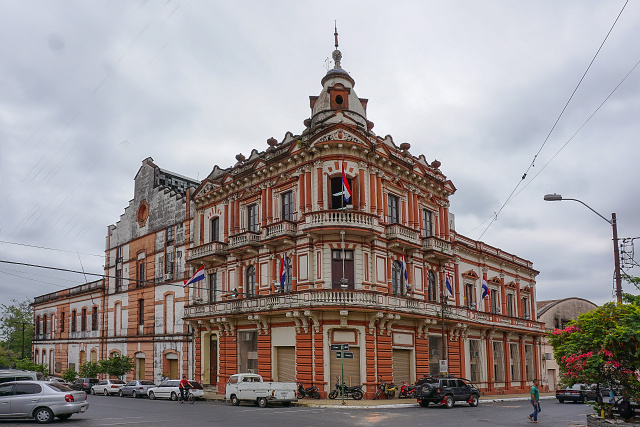
Asuncion: Example of imposing architecture....
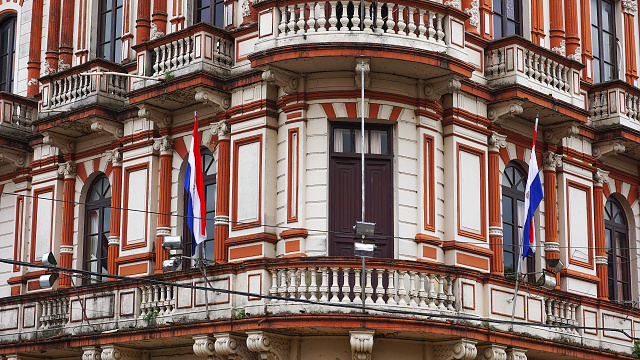
Asuncion: ...which decays and gets covered by grass
Meanwhile I had sufficient time to see Asuncion. To express it politely, there is not much to see. Only some colonial buildings have been preserved, most of them in very poor condition. The new buildings are even worse. All dominated by dirty facades, which appear to be overgrown in black mold. They do not seem to care much about maintenance, simply leaving buildings to gradually decay. Surprisingly, that even includes State buildings and historical sites (if there were any that could be termed as such).
The streets are dirty, covered in old leaves, rubbish, mess and with the remaining space taken over by street vendors. City parks are dominated by plants in a terrible state, grass as thin as my hair and, among it all, dusty dirt. It looks as if the city has not yet recovered from a long and terrible war. However, the people were fine, they seemed to be used to it and obviously did not mind the state of the city.

Asuncion: Pantheon on Plaza Central
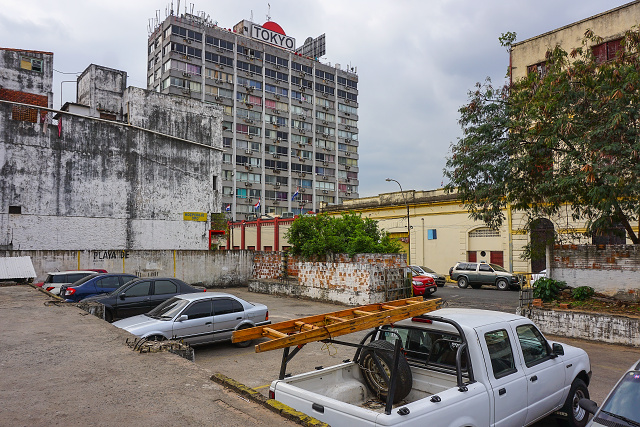
Asuncion: Common apppearance of the buildings in the center
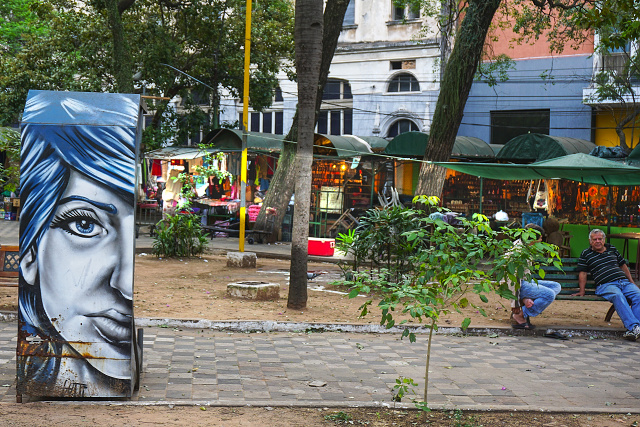
Asuncion: The back of a shoe cleaner’s booth on Plaza Central
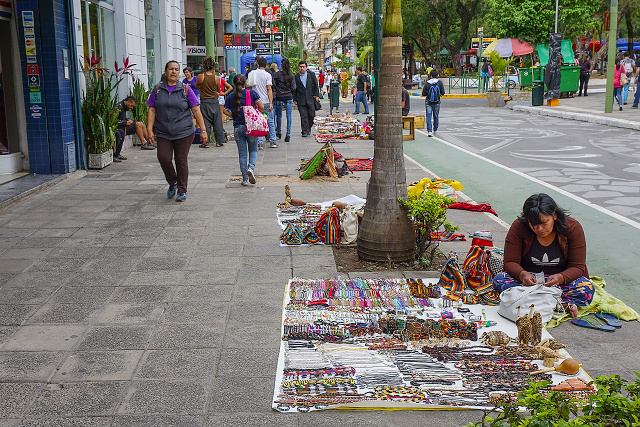
Asuncion: Abundance of vendors in the center
I have to note that the photos I took there do not represent the local atmosphere and situation well and instead make it look far too nice. I have also published only the best photos, the others are boring with the same gray-black colors.

Asuncion: Manzana de la Rivera - restored remnants of colonial architecture
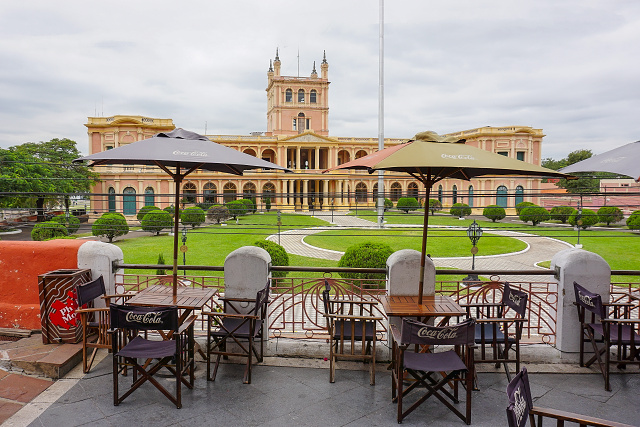
Asuncion: Governmental Palacio de los Lopéz
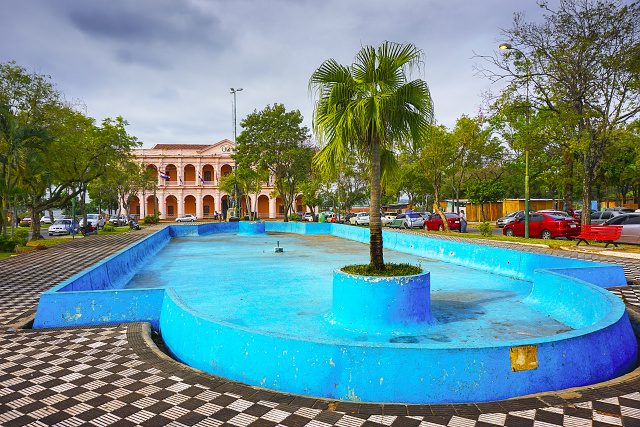
Asuncion: El Cabildo with dry, dirty pool in the foreground
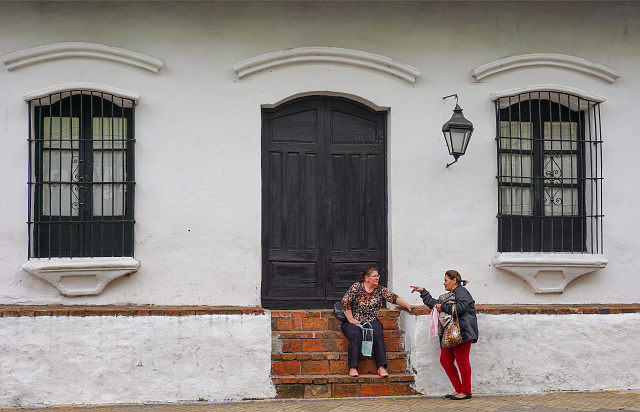
Asuncion: Old women gossiping outside Casa de la Independencia
I was shocked by the statue of dictator Stroessner in Palacio de los Lopéz Park. They smashed up his original statue and then cast it into a concrete block. The result is quite shocking and definitely fulfills the intention of its artists. This is a good way to handle similar persons, such as the Lenins, Gottwalds, Stalins and others.
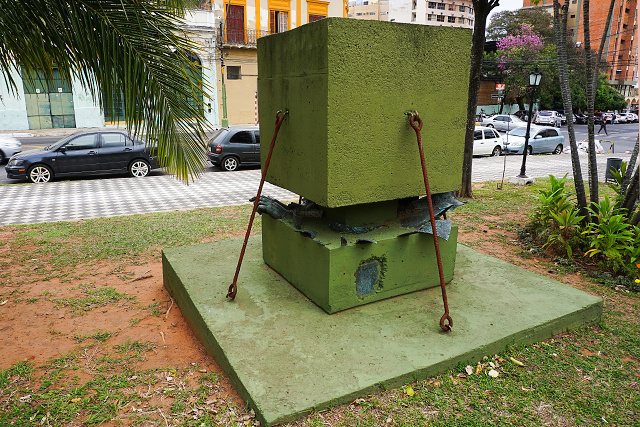
Asuncion: Statue of dictator Stroessner
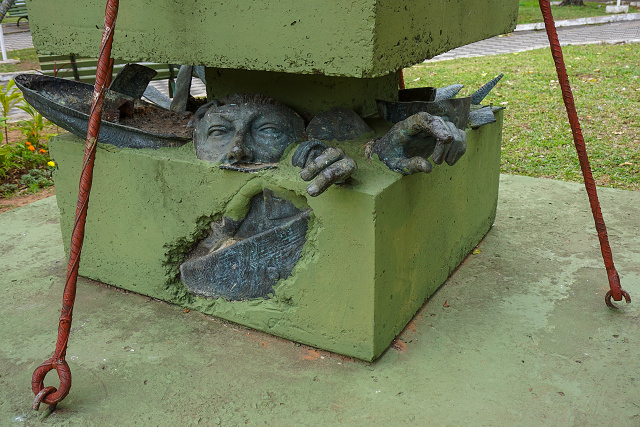
Asuncion: Statue of dictator Stroessner – detail
There have been some attempts to freshen up the embankment of the Paraguay River. Embankments usually serve as oases of rest in modern cities and also venues for recreational sport, restaurants and cafés. This seems to have gone wrong in Asuncion, as the embankments are taken over by the poorest people, who cover it in little shanties of plywood and corrugated iron sheets. This wide area of slums, which it is not recommended to enter, is located right under the windows of the Parliament building. The locals, however, have no choice but to go through it, as a street leads right through it, for example, to the Yacht Club. I witnessed a situation when a man in a suit stepped out of his expensive car and children from a shanty started throwing trash at him.
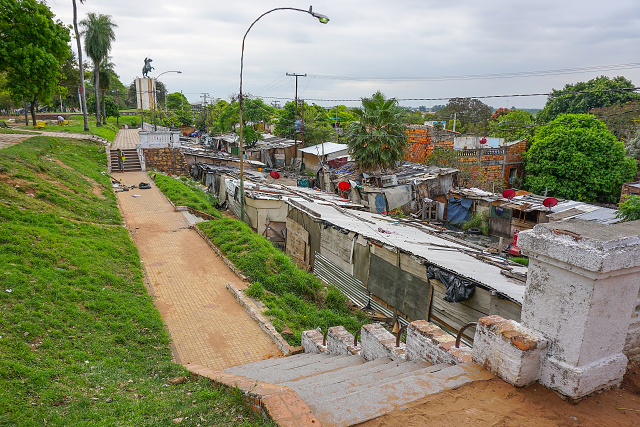
Asuncion: Poorest people live in slums close to Parliament
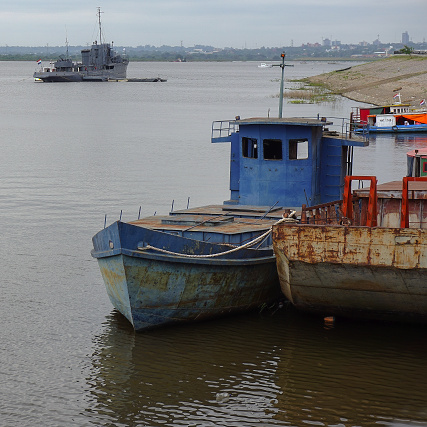
Asuncion: Gulf of Paraguay River
I had some problems filling up my equipment. It turned out to be impossible to find a place which sold cylinders for my cooker. I thought about Bolivian La Paz, where I could purchase one literally on every corner. I was saved in my hostel, where they gave me a partially used one, which was left there by another tourist who had left the country. After some efforts to find one, I also purchased a road map. Nevertheless, I could have skipped that, as it did not contain any more details than the road plan I had received free of charge at the Airport tourist office.
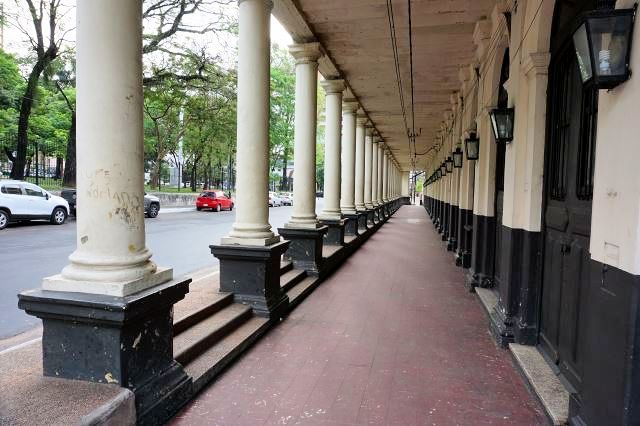
Asuncion: Railway Museum in the former main station
Otherwise I was happy. Food could be purchased on every corner, the beer was drinkable and Chilean wine was sold at reasonable prices. I looked forward to hitting the road the following day and heading East towards Iguazu Falls.
It's Still Working
The start of every trip is always a bit uncertain. I write about this every year. All my doubts usually vanish at the very moment when I am seated on my fully loaded bicycle and start pedaling into the unknown. Luckily, even my increasing age has not changed anything about this sensation, for which I am very grateful.
I had a hard time packing up my gear in the morning. I was yet to get my routine back, which did not return automatically, and figure out what belonged in each bag. After a very fair breakfast, included in the price of the room, I bade a warm goodbye to the owners (I was by far the oldest guest there and therefore the most honored one) and headed straight into the busy traffic. As it was a Saturday, I had rather expected light traffic. I started out towards San Lorenzo and the first 30 km to Itauguá were pure suffering.
The road was packed with cars and people shopping at the massive number of stores. Buses slowed down for people to jump off while still moving, several times almost into my arms. Street vendors leapt on to the slow-moving buses and then jumped off several meters later, if discovering that no bus passenger was interested in buying their products. The verges were wrecked, often filled with water (even though it had not rained for several days). Everyone was in a hurry, drivers forced their cars into tiny gaps. In all this chaos, I tried to find a way of getting out of there without any injury.
It all got better on Road 2, which generally had a meter-wide verge, so one might have got the idea that everything was problem-free there. Wrong! The verge was debased by low transverse ridges, apparently to warn drivers not to drive off the edge. For a cyclist, this meant that every 50 meters, the front wheel had to be jerked to reduce the damage of hitting those bumps. It was demanding.
The scenery was not worth much. Towns lack any kind of impressive buildings and the countryside is filled with agricultural, slightly hilly landscape with no distinctive elements. I did not even take a single photo on the way, except the three Brazilian cyclists I met coming from the opposite direction.
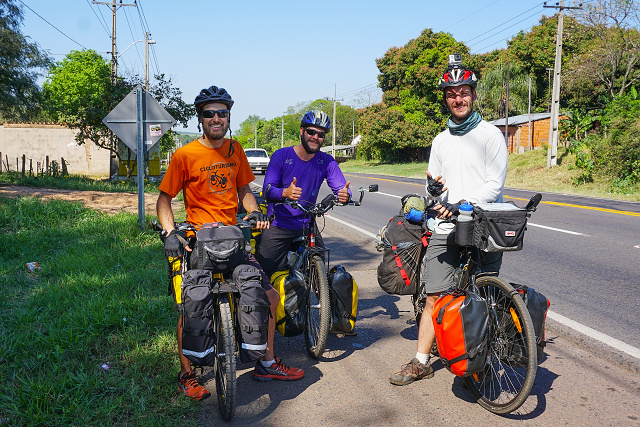
Caacupe: Boys from Brazil cycling in the opposite direction
The sun started to set there at about 17:30. This is why I already started searching for accommodation at 15:00. I stopped in Eusebio Ayala and expected it to be similar to Mexico, where I was certain to find a hotel or hospedaje in the city center. No chance! And when I mentioned my tent, they sent me to the police station to see if they could keep an eye on me during my night in the park. I still had some time, so continued on my way instead.
I came across a motel beside the road. The sign displayed "24 hours", so it was clear that it is an hourly hotel. I went in to ask anyway, as I wanted to know their rates. It was 30 000 PYG (CZK 150, $7.50) for the first hour, and every hour thereafter cost 10 000 PYG (CZK 50, $2.50). The owner spoke English and informed me that one hour was usually sufficient for most people. The motel was empty, business was stagnating, he informed me. Nevertheless, he did not offer any reasonable rate for the whole night, so I left. It seemed as if I would have to sleep over at a gas station. The verges of the roads were usually fenced off, so not suitable for pitching a tent.
10 km later, Yhaguy Hotel appeared. At first sight, everything seemed fine. A wide complex of buildings in a dense green area beside a clean river. It all turned out to be heavily shabby, yet the owner was willing to accommodate me. She wanted 100 000 guarani (CZK 500, $25) for bed and breakfast. After seeing the place, I offered her half of this sum for it and we made a deal. Her husband (I think) spoke only Portuguese, but this was no hindrance to him for giving me a half-hour long introduction to his entire family history. There was also a 14-year-old boy, who was annoyed with his grandmother for agreeing to a discount. I explained to him that, considering the state of the rooms, my offer was in fact very generous. He probably understood.

Yhaguy: Evening in the hotel garden
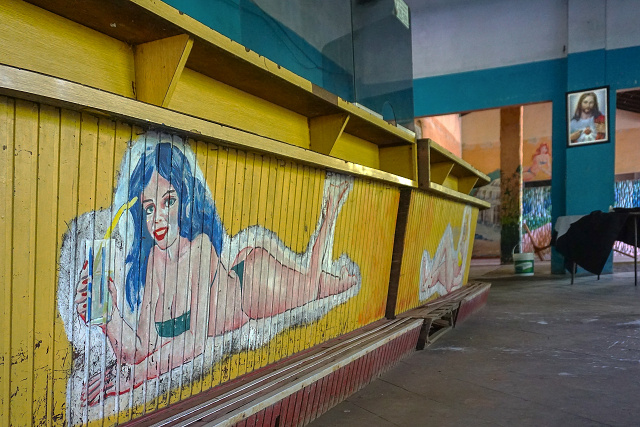
Yhaguy: Hotel decor combining chaste sex of the fifties with religious themes
The accommodation included breakfast. I had enjoyed a great breakfast at Nomade Hostel. I had no such expectations here. Many hens were running around the buildings, so I hoped to receive at least some huevo (egg). The reality was even worse – two pieces of bread with undrinkable tea with milk. When I reached San Jose after 15 km, I made up for it. In the local supermercado they were selling hanks of beef with something like ravioli, tasty and cheap. I ate it right in front of the store and was filled with energy, ready to continue the journey.
The weather was the same as the previous day: cloudless sky, maximum temperature of 41 degrees Celsius, a light headwind. There was not much point taking photographs in such weather. And the landscape was all the same, just undulating like the road in both directions (luckily only a slight ascent). I repeatedly cursed the retarded road project manager who had installed the rumble strips on the verges, which limited the use of one's potential energy when cycling downhill. I was not the only one to be annoyed by them, the verges were also used by many scooterists and motorcyclists, who swerved between the road and the verges and back again. It seemed that, close to settlements, people had taken the issue into their own hands and had hacked tire-wide pathways in the rumble strips.
I would photograph the countryside later, meanwhile I published a photo of a local meat store, which had parts of animal carcasses hanging in the shade under the roof, evidently good for the meat.
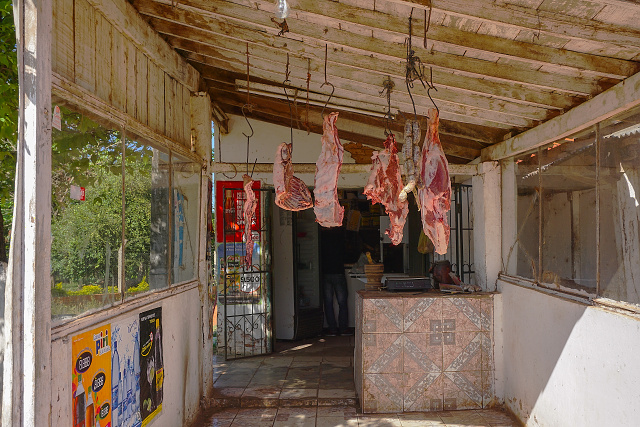
San José: Meat store
I passed through a series of villages and little towns, nothing intrigued me. Not even the churches were visible, probably located away from the main road. Nevertheless, there were no problems about food, every few kilometers there was some sort of a folk eatery, bakery or small store. One needed to keep an eye on the prices, ask how much an item cost before purchasing and then check if the change returned was correct. They tried twice to cheat me out of 10 000 Guarani (CZK 50, $2.50). I smiled, indicated with my finger to keep giving the change and they immediately shelled out the rest. They try this on stupid gringos.
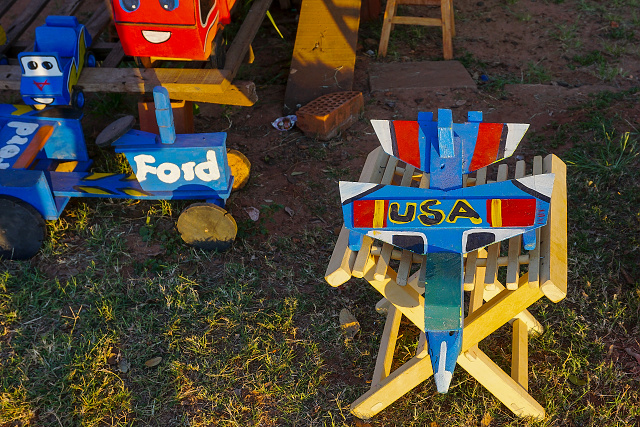
Caaguazú: Toys sold at the roadside in carpentry workshop, no prejudices against USA
I had cycled over 90 km by the time I reached Caaguazú. I spotted a sign for hospedaje (accommodation). The negotiation was complicated, because I had missed the sign 24 horas, which could be seen at hotels renting rooms per hour. We finally agreed on 5000 Guarani (CZK 250, $12.50) for a stay from 17:00 to 07:00 the next day. They only had one room and it was obvious that they would not trap any excited guest at that time. Perhaps I should have continued on for a few more kilometers as there were about three hotels in the town itself.
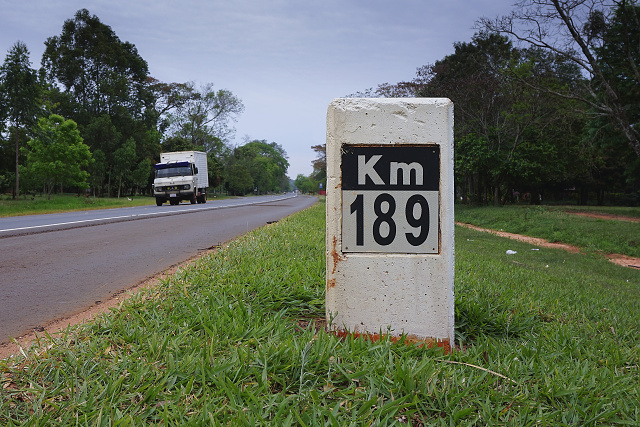
Near Caagyuazù: Road 7
At 07:00 I was already on the road. I had set my GPS to wake me up at 06:00. Breakfast at a bus station followed lo mismo (the same thing) as the day before. The scenery was a carbon copy of the previous day. Only the weather improved slightly with some clouds. The headwind got a bit stronger. I passed through a series of small towns which Stroessner had named after his friends. These were not so popular and unofficially other names were used. For example, J. E. Estigarribiase was called Campo 9.
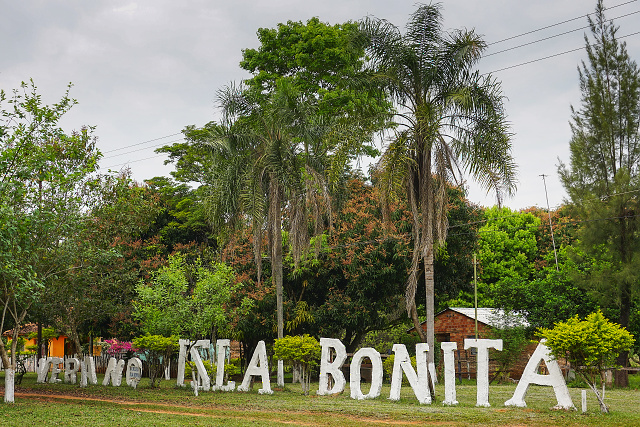
Near J.E.Estigarribia: Verano Isla Bonita
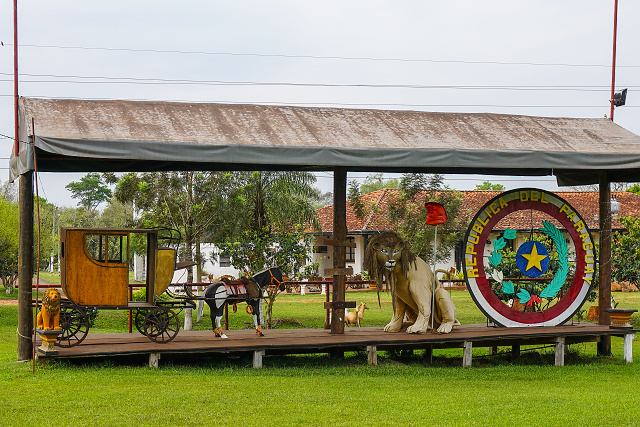
Near J.E.Estigarribia: Decoration of ecological station
I still had 140 km to Ciudad del Este (earlier called Ciudad Stroessner). I made a halfway stop in Juan E. O'Leary, where I spotted a pleasant looking hotel, also at a reasonable rate (CZK 300, $15). There was only one disadvantage. The room, just like the other rooms, had no window. I woke up in the night due to the heat, so I left the door open and then the mosquito flew in. I had to use the repellent, close the door and turn on the air-conditioning much to my inborn dislike. The air-conditioning made a really loud noise close to morning and, when I awoke, I realized that it was heavy rain, not the air-conditioning, that was making the noise.
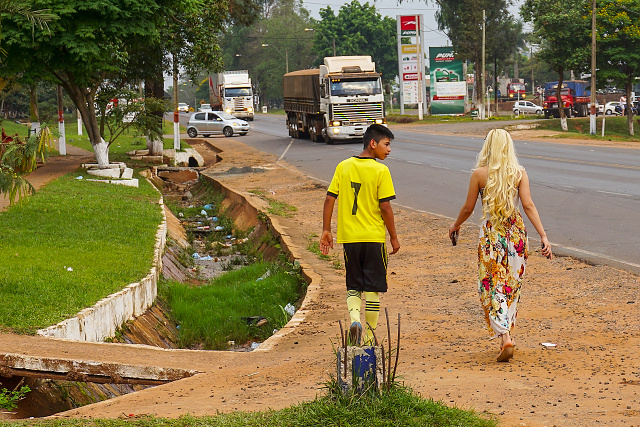
Juan E.O'Leary: Blonde
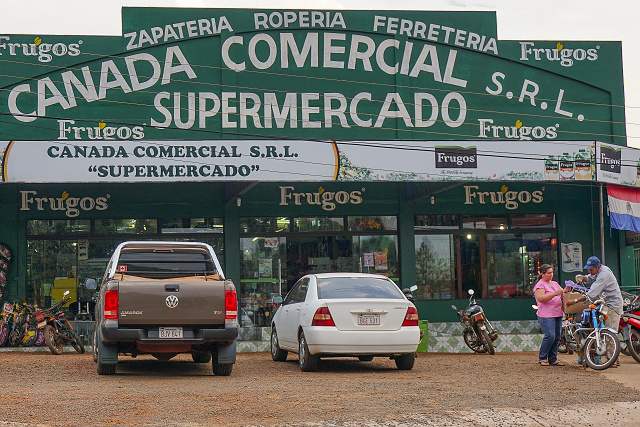
Juan E.O'Leary: Supermarket
Juan E.O'Leary: Village square
I have to mention the local showers, they are the same as in Bolivia. They contain run-through water heaters. Since the power of the heater is constant, the water temperature is regulated by the water running through. The warmer the water you need, the less you open the faucet.
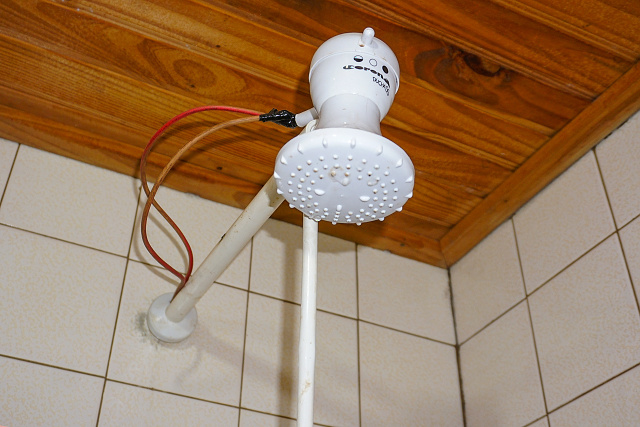
Juan E.O'Leary: Shower
El dolor de cabeza
Learning languages is great. I had learned how to say "a headache" and, a few days later, I could already use this phrase. It was not the head, it was my neck, but the pain was fierce. I could not turn my head to the left, which was quite inconvenient in busy traffic. When it got worse, I had to hold my head in my hands, for example, in order to sit up in bed. I had no option but to apply my universal medicine. I used a towel to make a Priessnitz bandage, let it act over half of the night and it got distinctly better.
At 07:00 it was still raining cats and dogs, the sky was cloudy from horizon to horizon and it seemed as if it was going to continue this way for the whole day. I was not too concerned, I slept in for another hour and at 08:30 it was over. The cloudy sky made for very favorable cycling conditions, the headwind was gentle, so that cloud had a silver lining. The sun came out at midday. One could feel the nearby large water surfaces in the air, the humid tropical heat was pervasive.
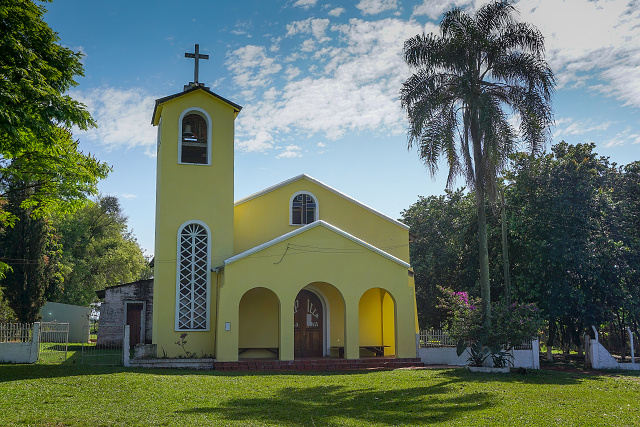
Dr. Juan L.Mallorquín: Village church
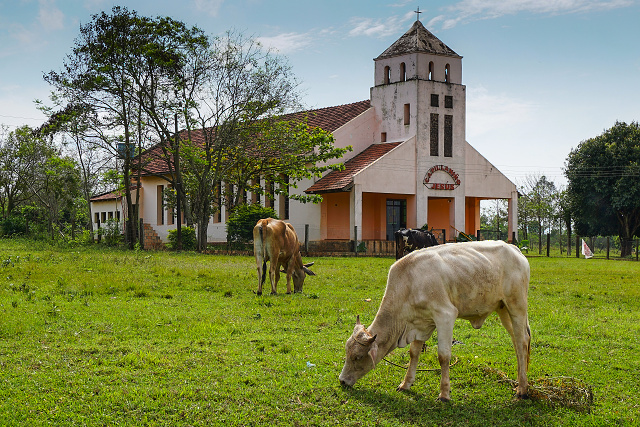
Near Yguaz: Church
The sun was not baking down, so taking photos was possible and I enjoyed the ride through the pleasant surroundings. Only the hotel breakfast was a bit weak and after 50 km I was as hungry as a wolf. At a roadside home kitchen, I ordered meat with rice and frijoles with cabbage and manioc. The portion was enormous, at least 200 g of meat, but I managed it with pleasure. I complimented the chef, saying that it was like the food made by my mother. She was happy. I should have said that it was like the food made by my wife (I would have managed that in Spanish, too), but it would not have had the same effect. At least I could compliment her here from a distance. My wife cooks really well!
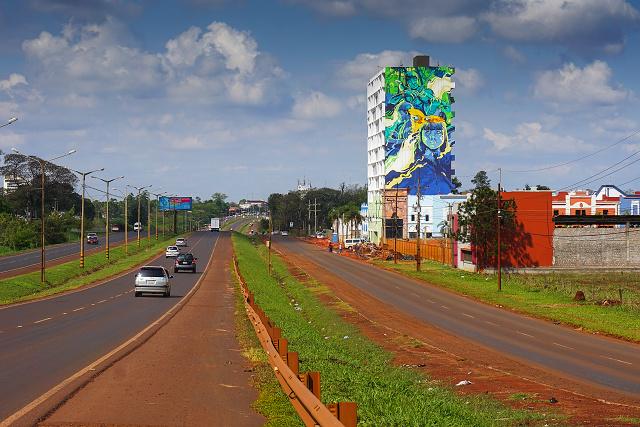
Ciuadad del Este: Arrival in the city via Road 7
It is hard to cycle with a full belly. I was happy that I had somehow taken myself over the last 15 km. The traffic became dense, plenty of trucks that were mostly parked on the side of the road 8 km before the border bridge, with the drivers waiting their turn. It seemed as if it was going to take a long time, so they took out their camp chairs and tables, cooked, chatted and played cards.
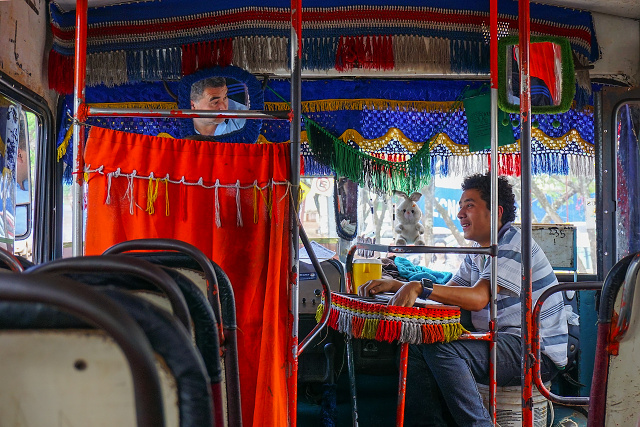
Ciuadad del Este: Public bus conductor
Ciudad del Este
The city was earlier called Ciudad Presidente Stroessner, which was then replaced by the relatively indistinct name. Its location is on the border with Brazil and Argentina. It is famous for cheap shopping, especially for electronics, brand-name clothes, luxury accessories and shoes. Street stores compete with the shopping malls called Galéria. If you do not wish to purchase anything, as in my case, it becomes very annoying as you are continuously being offered something. Their favorite trick is to push something cheap into your hand, giving it to you free of charge. You then return the object and thus establish contact with them and then they start pushing you to buy their items.
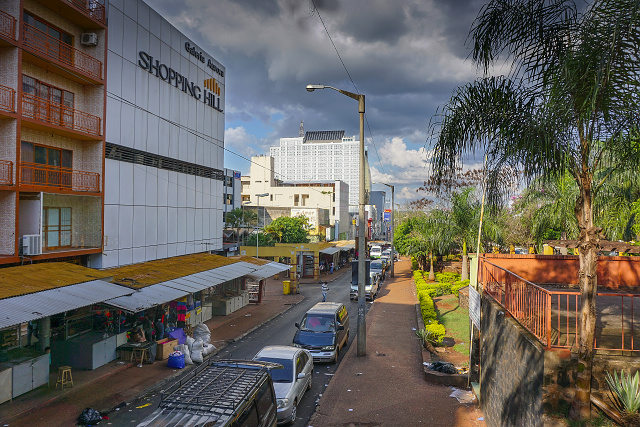
Ciuadad del Este: Main shopping street - Avenue San Blas
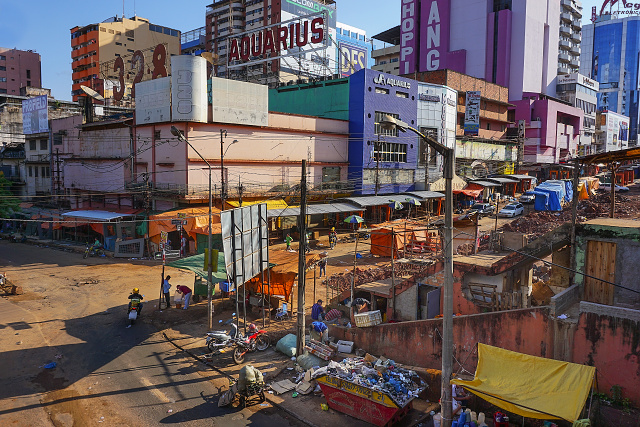
Ciuadad del Este: The center is quite a mess due to repairs and construction
I went to check out the allegedly best Galéria de Mona Lisa. It was of a good standard, but the prices were not astonishing. I checked out the cameras, the prices of which I have some knowledge, but they were the same as on Amazon.
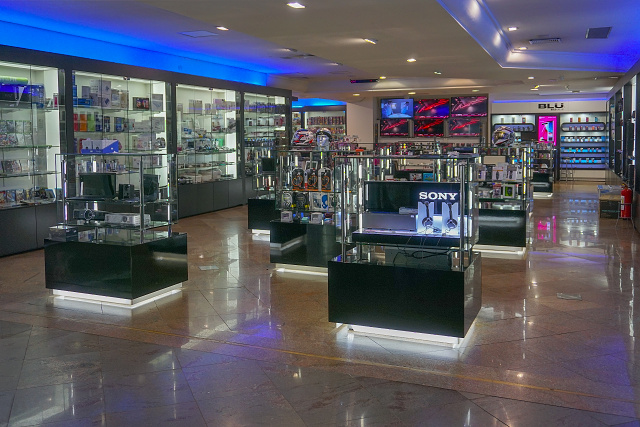
Ciuadad del Este: Polished Galéria Mona Lisa
Most importantly, I went to see the border bridge. The situation was chaotic, I would have to deregister at the Paraguayan passport control, otherwise I could have problems when entering the country again. The locals did not need to do this, this was why the passport control was fairly well hidden. American citizens needed visas for Brazil (and Bolivia and Venezuela), this is why the Brazilian side looked out for palefaces whom they controlled heavily. I was quite suntanned and weather-beaten, but it was still obvious that I was a white man.
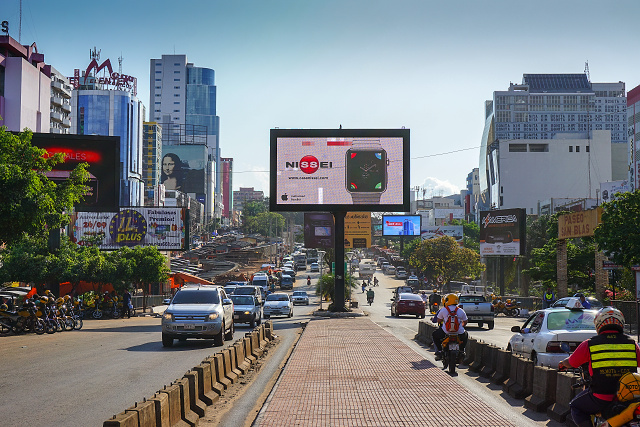
Ciuadad del Este: View of the city from bridge to Brazil
One Hour in Brazil
I started off early and that was a good idea. Little traffic, I received my exit stamp immediately. I was the only one there. I walked my bike across the pedestrian part of the bridge, because I wanted to photograph the border – the Paraná River. The dense fog, however, hardly allowed me to see even the surface of the water under the bridge. I searched for a while for the passport control booth on the Brazilian side. But there were no problems there either. I had to cross Foz do Iguacú (Portuguese). Except for some steep hills, this was also trouble-free. Directions to Argentina were well signposted and side lanes dedicated for cyclists were even marked on city center streets. I was praising this fact, until the very moment that a motorist nearly drove over me. I noted that the car was registered in Paraguay, there they are not used to such conveniences.

Foz do Iguacu (Brazilie): Downtown street
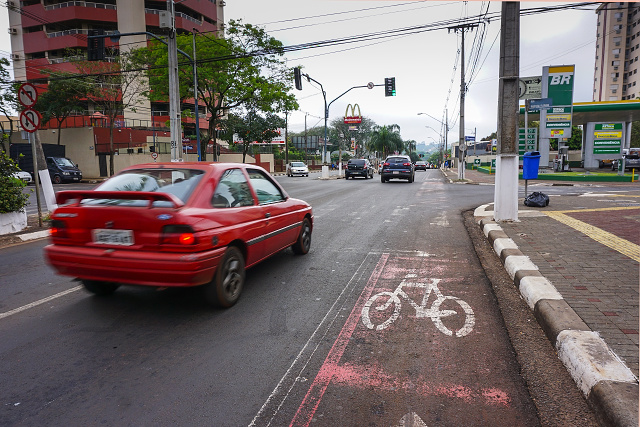
Foz do Iguacu (Brazilie): Special lanes reserved for cyclists in the city
One Day in Argentina
One hour later, I was once again at a bridge passport control, this time into Argentina. I crossed the bridge over the Iguazú River, passed the allegedly "Best Free Store in the World" and entered Argentina. I did not hang around Puerto Iguazú city and headed directly for the 17-km distant waterfalls.
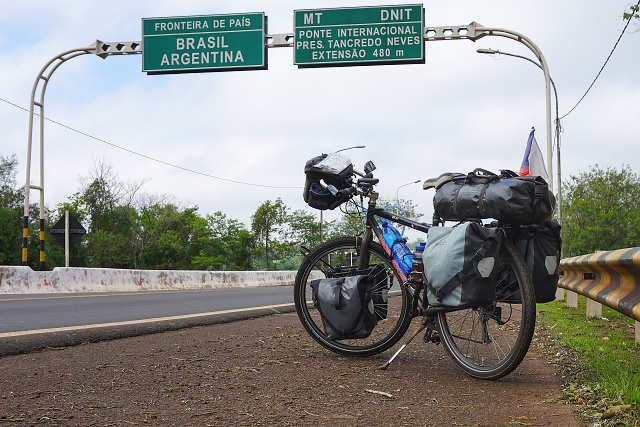
Foz do Iguacu (Brazilie): At the border bridge over Iguazú River
Iguazú National Park
The waterfalls were accessible both from the Brazilian and Argentinian sides. I chose the Argentinian one, as it had more routes around the falls. It was also more practical, I could use the rest of the exchanged pesos when traveling via Argentina later. The entry fee was a rip-off, 240 Pesos (approx. CZK 700, $35), but the prices were scaled. The locals pay notably less and also can take advantage of different discounts. I thought it made sense. Construction of the viewing paths had to cost a lot and it was paid from their taxes. Only back home, we are very careful not to give any advantages to locals.
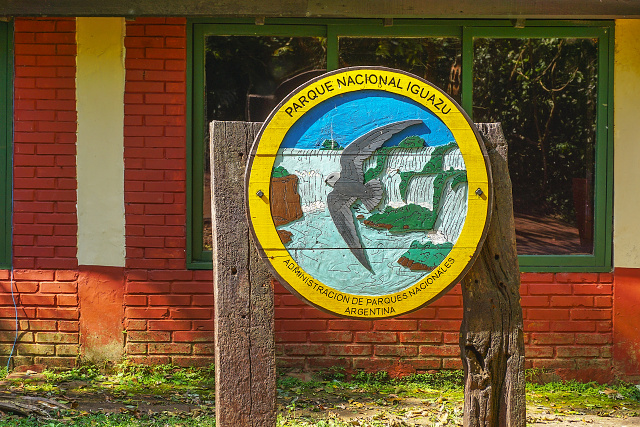
Iguazú Falls: Symbol of Iguazú National Park
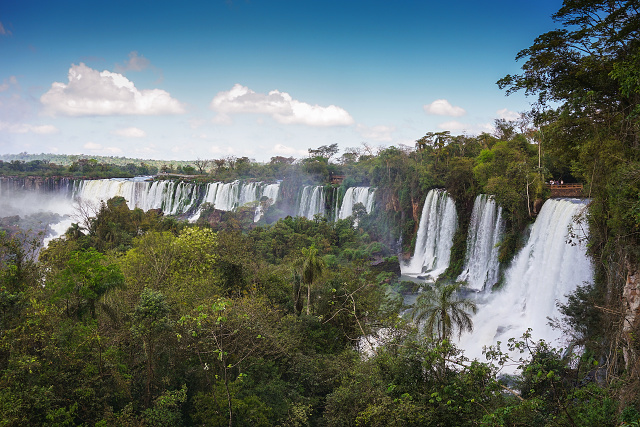
Iguazú Falls: Clear photo of larger section of the waterfalls
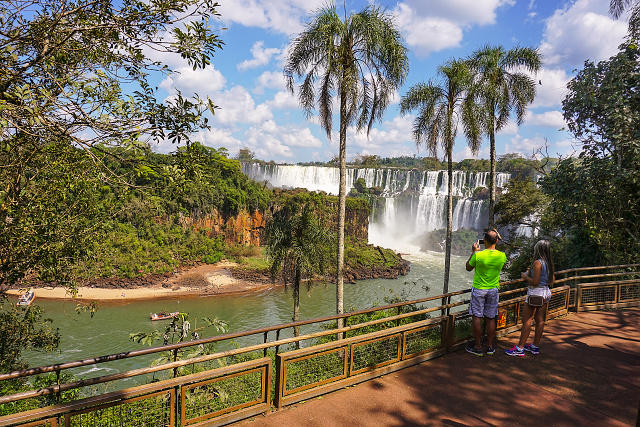
Iguazú Falls: Palm trees framing nearby waterfalls
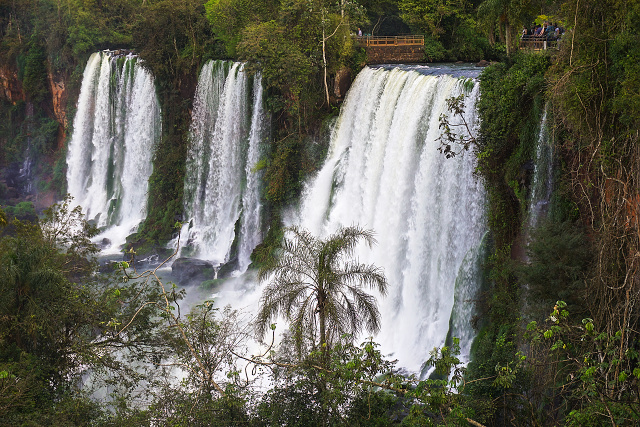
Iguazú Falls: Waterfalls and palm tree
Never mind the money – the falls were amazing! From the upper circular path, one gets above the waterfalls. The power of the water falling down with a roar is mesmerizing. When you then exit the thick forest, a ring of waterfalls opens up, whose crown must be more than a kilometer long. The lower circular path affords other views, one can get very close to some of the falls. One can even watch small boats hitting the roaring waters, covered in spray and often with a rainbow above them.
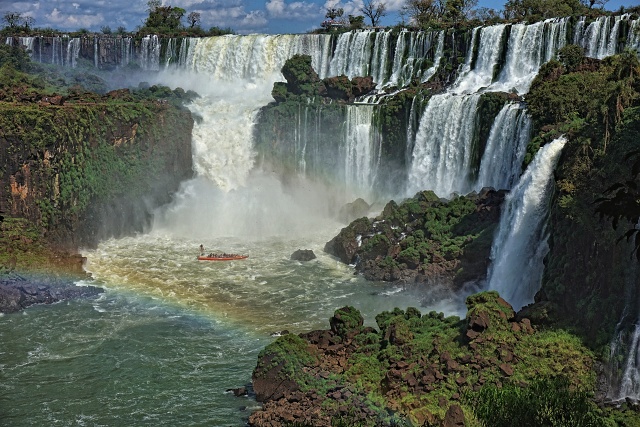
Iguazú Falls: Boat beneath the waterfall (behind the rainbow)
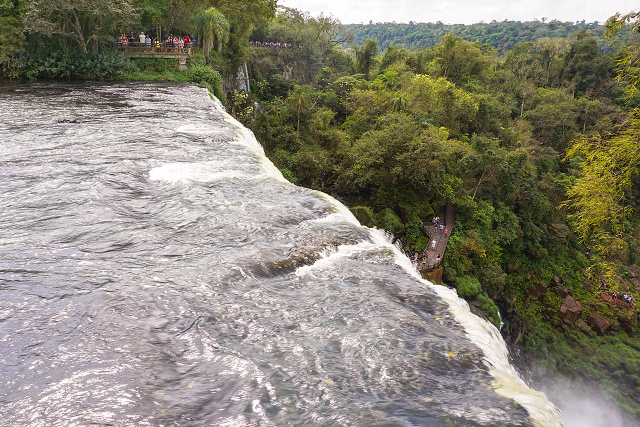
Iguazú Falls: Waterfall edge
Butterflies were flitting about everywhere, Coatis were running in the forest and mainly around the kiosks, intermingling with the people and often stealing their purchased food directly from the tables. The visit amazed as well as exhausted me. I walked many kilometers in quite severe heat. I noticed that group tours usually managed only the upper walks and then gave up. I was surprised that people came all the way there, for example from Germany, and then skipped over it like that. It is necessary to add that the most distant part of the falls, the Devil's Throat, can only be reached by tourist train. The train did not have sufficient seating for passengers, so there was a two-hour line for it. The moonlight tours must be amazing. They are organized over five days of the month, around the full moon phase.
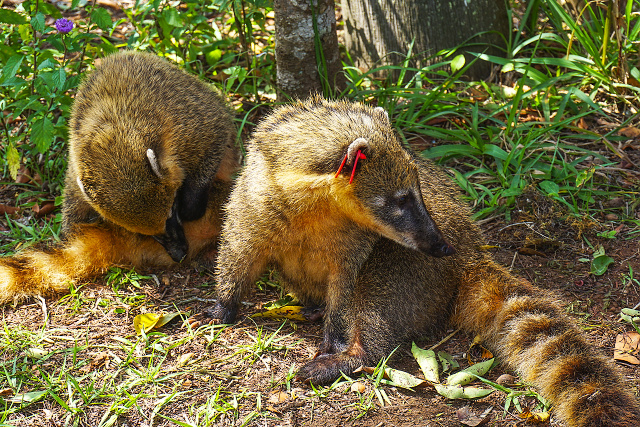
Iguazú Falls: Coatis – omnipresent and impudent – stealing food
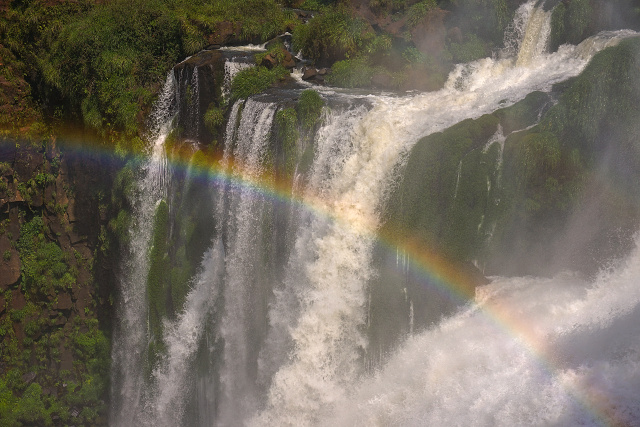
Iguazú Falls: Rainbow over the waterfalls
I gave up after 15:00 and cycled back to Puerto Iguazú. I picked a camp closest to the Paraná River on my GPS, which I then reached shakily through terrible streets lined with sharp stones. The campsite was simple, but good. The toilets seemed way too cheap, but the shower was the warmest I had thus far experienced, even though it was the same run-through heater as everywhere else. Perhaps their electrical power is of a better quality than in Paraguay. I needed to eat. There were a few small stores nearby which were about to close. They had beer, so out of four eggs and a can of luncheon meat, I made a tasty and nutritious meal on a stove plate. As I could not get hold of any bread, it was good that I had the liquid type.
There was also a French family with three small kids in the campsite. They had had their caravan transported over the ocean and were in the middle of their two-year trip through South America. We had a good chat and then, for the very first time that year, I slept in my tent.
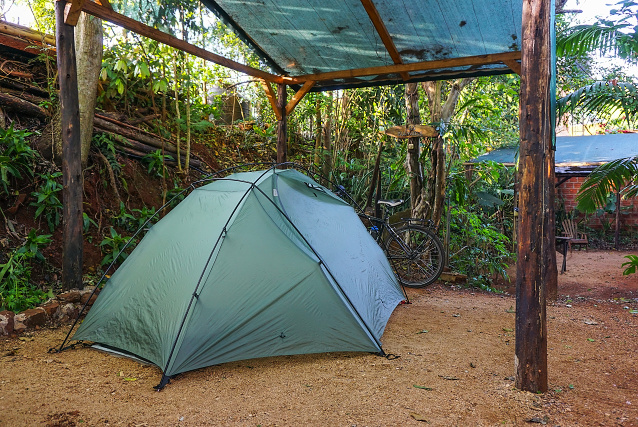
Puerto Iguazú: First night in the camp







